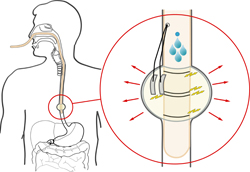Help is on the (GI path) way for diabetes patients
Autonomic neuropathy, a set of symptoms presenting when there has been damage to the nerves managing everyday bodily functions, can affect blood pressure, bowel and bladder emptying, digestion and heart rate. Despite the existence of various tests for neuropathy, these are neither reliable nor valid, and lack of standardisation poses a problem. This shortcoming highlights the need to develop better biomarkers for gastrointestinal neuropathy and related complications. Also, reliability and validity must be tested under controlled conditions, and improved multimodal methods and biomarkers must be followed during new treatments. The 'Sensory and biomechanical markers in diabetic neuropathy of the gut. Basic investigations and new approaches for treatment' (Diamark) project has set out to identify new biomarkers for autonomic neuropathy so as to better predict the effects of gastric pacing in diabetic patients. Gastric pacing to treat morbid obesity uses an external pacemaker device and wires to penetrate gastric tissue and stimulate the cells, in order to facilitate gastric emptying. Initial work in this EU-funded project concentrated on developing and validating methods, with new probes being developed to deliver electrical stimulations in the oesophagus. The probes were tested in various experiments to reveal the most reliable and robust method. Researchers have also worked to evaluate the brain-gut axis with a range of imaging and neurophysiologic methods. Recording techniques for an electroencephalography (EEG) system has been optimised and algorithms for inverse modelling and classification of EEG traces have been successfully implemented. Two sets of experiments have been conducted to validate methods, with initial results showing the methods to be reliable and robust. Diamark scientists are continuing to complete experimental protocol and assess test results.







